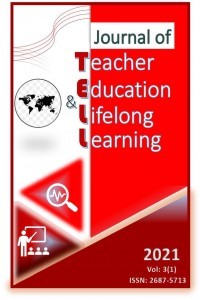The Effect of Coding Education Designed with Different Visual Programs on Academic Success and Attitudes and Self-Efficiencies of Secondary School Students
The Effect of Coding Education Designed with Different Visual Programs on Academic Success and Attitudes and Self-Efficiencies of Secondary School Students
computerized coding, academic success, self-efficacy perceptions in computer assisted education computer assisted education attitudes, educational computer games supported coding training,
___
- Arslan. (2006a). Bilgisayar Destekli Eğitime İlişkin Öz Yeterlilik Algısı Ölçeği. Abant İzzet Baysal Üniversitesi Eğitim Fakültesi Dergisi, 3(2), 24-33.
- Arslan. (2006b). Bilgisayar Destekli Eğitim Yapmaya İlişkin Tutum Ölçeği. Yüzüncü Yıl Üniversitesi Eğitim Fakültesi Dergisi.
- Baş, G. (2011). İlköğretim Öğretmenlerinin Eğitsel İnternet Kullanımı Öz- Yeterlik İnançlarının Farklı Değişkenler Açısından İncelenmesi. Eğitim Teknolojisi Kuram ve Uygulama, 1(2), 35-51.
- Batdal, G. (2005). Öğrenci Odaklı Bir Yaklaşımla İlköğretim Matematik Programlarının Değerlendirilmesi. XIV. Ulusal Eğitim Bilimleri Kongresi Kitabı, 343-346.
- Büyüköztürk, Ş., Çakmak, E., Akgün, E., Karadeniz, Ş., & Demirel, F. (2012). Bilimsel Araştırma Yöntemleri.(12. Basım). Ankara: Pegem Akademi.
- Creswell, J. W., & Clark, V. L. P. (2017). Designing and Conducting Mixed Methods Research: Sage publications.
- Demir, G., & Seferoğlu, S. S. (2017). Yeni Kavramlar, Farklı Kullanımlar: Bilgi-İşlemsel Düşünmeyle İlgili Bir Değerlendirme. Eğitim teknolojileri okumaları, 801-830.
- Ercan, İ., & Kan, İ. (2004). Ölçeklerde Güvenirlik ve Geçerlik.
- Ergin, Y. D. (1995). 1. Ölçeklerde Geçerlik ve Güvenirlik.
- Geçer, A. K., & Funda, D. (2010). Bilgisayar Okur-Yazarlık Düzeylerinin Belirlenmesi: Kocaeli Üniversitesi Örneği (ss, 20-44). Yüzüncü Yıl Üniversitesi Eğitim Fakültesi Dergisi, 7(1), 20-44.
- Gomes, A., & Mendes, A. J. (2007). Learning to Program-Difficulties and Solutions. Paper presented at the International Conference on Engineering Education–ICEE.
- Karabak, D., & Güneş, A. (2013). Ortaokul Birinci Sınıf Öğrencileri için Yazılım Geliştirme Alanında Müfredat Önerisi. Eğitim ve Öğretim Araştırmaları Dergisi, 21(2-3), 163-169.
- Karasar, N. (1999). Bilimsel Arastırma Yöntemi. Ankara: Nobel Yayın Dağıtım.
- Keçeci, G., Alan, B., & Zengin, F. K. (2016). Eğitsel Bilgisayar Oyunları Destekli Kodlama Öğrenimine Yönelik Tutum Ölçeği: Geçerlilik ve Güvenirlik Çalışması. Education Sciences, 11(3), 184-194.
- Kırkıç, K. A., & Aydın, E. (2018). Merhaba STEM Yenilikçi Bir Öğretim Yaklaşımı: Eğitim Yayınevi.
- Lee, Y.-J. (2011). Scratch: Multimedia Programming Environment for Young Gifted Learners. Gifted Child Today, 34(2), 26-31.
- M.E.B. (2012). Bilişim Teknolojileri ve Yazılım Dersi (5,6.7 ve 8. Sınıflar ) Öğretim Programı.
- Malan, D. J., & Leitner, H. H. (2007). Scratch for Budding Computer Scientists. ACM Sigcse Bulletin, 39(1), 223-227.
- Miles, M. B., Huberman, A. M., Huberman, M. A., & Huberman, M. (1994). Qualitative Data Analysis: An Expanded Sourcebook: sage.
- Roy-Singh, R. (1991). Education for the Twenty-First Century: Asia-Pacific Perspectives: Unesco Principal Regional Office for Asia and the Pacific.
- ScratchAbout. (2020), Retrieved from https://scratch.mit.edu/about/, Erişim Tarihi: 06.12.2022.
- Somyürek, S. (2014). Öğretim Sürecinde Z Kuşağının Dikkatini Çekme: Artırılmış Gerçeklik. Eğitim Teknolojisi Kuram ve Uygulama, 4(1), 63-80.
- Strauss, A., & Corbin, J. (1998). Basics of Qualitative Research Techniques: Sage publications Thousand Oaks, CA.
- Tospaa. (2020). Tospaa Bilgisayarsız Kodlama Oyunu. Retrieved from http://tospaa.org/, Erişim Tarihi: 03.09.2019.
- Tsai, M.J., & Tsai, C.-C. (2003). Information Searching Strategies in Web-Based Science Learning: The Role Of Internet Self-Efficacy. Innovations in education and Teaching International, 40(1), 43-50.
- Ünsal, K. (2019). Ortaokul ve Lise Yöneticilerinin Kodlama Eğitimine Yönelik Görüşlerinin İncelenmesi (Bağcılar İlçesi Örneği) (Yüksek Lisans Tezi), Marmara Üniversitesi.
- Yildirim, A., & Simsek, H. (2008). Sosyal Bilimlerde Nitel Araştırma Yöntemleri. Ankara: Seckin Yayınları.
- Yildirim, B., & Selvi, M. (2017). Stem uygulamalari ve tam öğrenmenin etkileri üzerine deneysel bir çalişma. Eğitimde Kuram Ve Uygulama, 13(2), 183-210.
- ISSN: 2687-5713
- Başlangıç: 2019
- Yayıncı: Ertuğrul USTA
An inquiry and context-based activity supporting lifelong learning: Enzymes in Daily Life
Fatma ŞAŞMAZÖREN, Feride ŞAHİN
Lise Öğrencilerinin Coğrafi Bilginin Günlük Yaşama Yansımalarına İlişkin Değerlendirmeleri
Ufuk SÖZCÜ, Abdullah TÜRKER, Erkan DÜNDAR
Lisansüstü Eğitim Tutum Ölçeğinin Geliştirilmesi: Geçerlik ve Güvenirlik Çalışması
Şaban ÇETİN, Kübra EKE, Hatice Büşra YILMAZ, Tülay Gül TAŞKIN GÖKÇE, Busra GORKAS
Hidayet CAMCI, Yasemin BÜYÜKŞAHİN
Teslime DENİZ, Agah Tuğrul KORUCU
Erdal HAMARTA, Önder BALTACI, Ömer Faruk AKBULUT, Muhammed AKAT
Examining the Relationships between Death Anxiety, Meaning in Life, and Parental Attitude
Umay BALTACI, Zeliha TRAŞ, Mehmet AK, Şahin KESİCİ
A Science Teacher's Teaching Moves about Low and High Achieving Students: A Belief System Approach
